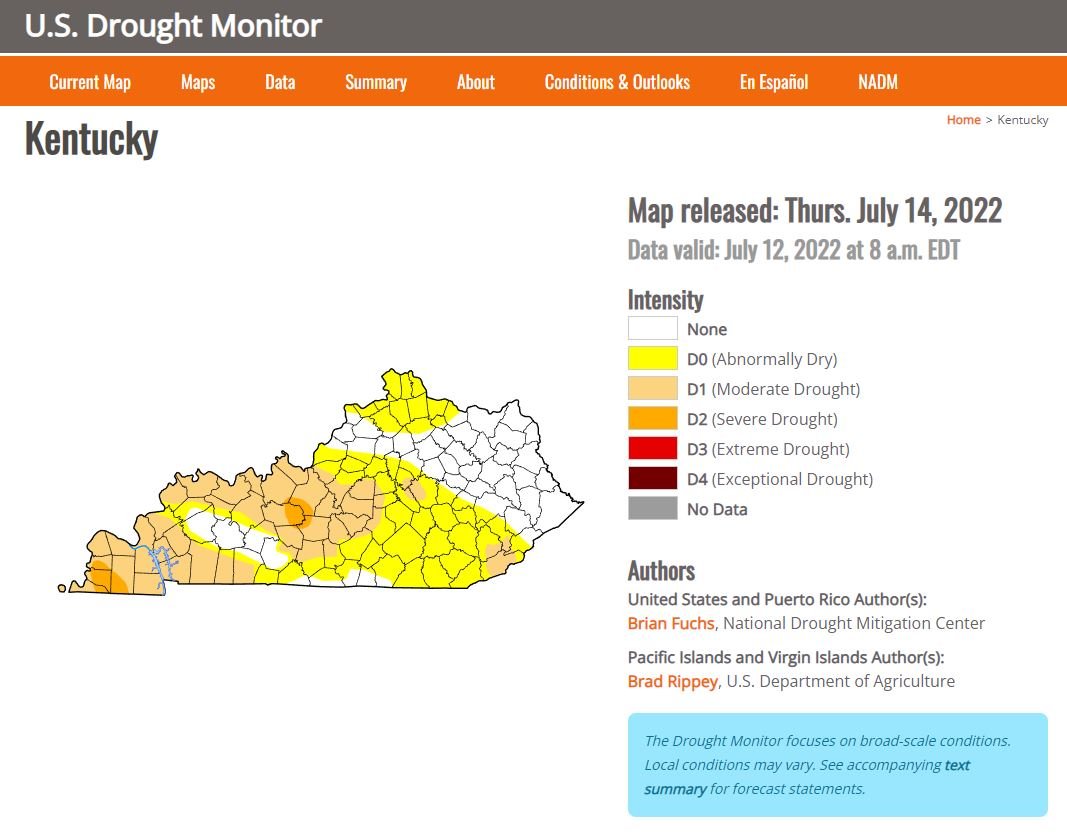Soybeans Response to Drought Conditions
Conner Raymond, Dr. Lloyd Murdock, Dr. Carrie Knott
According to the U.S. Drought Monitor, the vast majority of our grain-producing areas of the state are in a moderate drought or abnormally dry with spots of severe drought. With forecasts not showing much relief in the coming weeks, it will be helpful to understand and be able to identify drought stress in a soybean crop.
According to the University of Tennessee, soybean water requirements vary from 1 inch per week to 2 inches per week throughout much of the growing season (Table 1).
In Kentucky, it is typical to see double-crop soybeans germinating during the same period that the full-season crop is at or entering the reproductive stages. Germination and reproductive stages (specifically beginning pod R3 to full seed R6) are the stages where lack of moisture can have significant negative impacts on plant growth and yield. Soybeans have a fair amount of resiliency during brief periods of drought when in the vegetative stages of growth. If dry conditions occur during the vegetative stages, plant height may be impacted due to energy being concentrated on root growth to reach moisture deeper in the soil profile but minimal impact on yield is normally observed, along with shorter vegetative growth. When soil temperatures exceed 90°F nitrogen fixation can also be impacted. Symptoms of drought stress on soybeans include leaf flipping and leaf clamping. Leaf flipping (Picture 1) is when leaves on the upper part of the plant flip to expose the underside in an attempt to reflect light. When this occurs, photosynthesis is reduced, and growth is slowed. Leaf clamping (Picture 2) is when the leaf folds inward in an attempt to reduce water loss through transpiration.
Rainfall in June has been much below normal in almost all of Kentucky but has been very spotty with some areas being very dry with many areas only receiving about two inches of rain in the month of June. Soybeans in rapid vegetative growth, pod formation, and seed fill require about six inches of water per month for good growth. This leaves about four inches of water deficit for June. Deeper, uncompacted soil can easily fill the deficit with soil stored water. If drought conditions persist, shallow and compacted soils will begin to show significant drought stress.
Flowering is the first stage that drought has a significant effect. However, flowering can extend for several weeks, especially with indeterminate soybeans. This gives the plant a better opportunity to recover from short-term droughts. The most critical is early pod to mid seed fill, drought during this stage has the most effect on yield. According to the University of North Carolina, pod set for good yields is considered to be 50-100 pods per plant. If the drought is broken after pod set, the soybean plant can add more beans per pod or larger seeds depending on when the drought is broken.
Picture 2: Leaves on a soybean plant showing signs of clamping due to drought stress. Photos from Kinsey Hamby, UK Grain Crops Technician-Soybeans in Marshall County, KY
University of Tennessee soybean irrigation recommendations
University of North Carolina pod number estimates
Conner Raymond, Grains Extension Associate
Dept of Plant and Soil Science
conner.raymond@uky.edu
348 University Dr. Princeton KY, 42445
Dr. Lloyd Murdock, Emeritus Professor
Dept of Plant and Soil Science
lloyd.murdock@uky.edu
348 University Dr. Princeton KY, 42445
Dr. Carrie Knott, Director of UK Research and Education Center
Dept of Plant and Soil Science
carrie.knott@uky.edu
348 University Dr. Princeton KY, 42445
Table 1: Weekly water usage for soybean plants at different growth stages through the growing season
Picture 1: A leaf on this soybean plant in the center of this picture has flipped to the underside in an attempt to reflect light from the plant.




